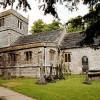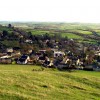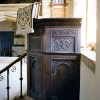On July 21st 1588 an explosion occurred on board a Spanish galleon, The ‘San Salvador,’ as she was sailing across Lyme Bay at the height of the Armada. Whether the explosion was an accident or, as has been surmised, an act of sabotage is not clear, but the smouldering hulk of the ‘San Salvador’ was abandoned and towed to Weymouth where rudimentary repairs were carried out, her crew presumably taken prisoner.
The ship had been carrying the Spanish Paymaster-General and most of his gold; a chest salvaged from the wreck was put on display in Weymouth Museum. Once reasonably seaworthy, the ship was thought to have sailed for Portsmouth with a British crew but actually foundered and sank before Old Harry Rocks near Studland. The crew then either abandoned the galleon or were drowned. There the ‘San Salvador’ lay rotting for nearly 300 years until marine archaeologists recovered some of her timbers in 1984.
The wreck of the ‘San Salvador’ is just one of the earliest recorded instances of shipwrecks around the coast of Purbeck. Most notably, St. Aldhelm’s Head, the Kimmeridge Ledges and Durlston Head have all been treacherous graveyards of many a vessel and its crew. News of a wreck once spread rapidly between villages and farms. As if to a honeypot the people were irresistibly drawn towards the spectacle of these tragedies, though principally not from any humanitarian motivation. They came to plunder and salvage whatever booty they could from a hapless wreck to enrich the lowly economy of their communities or the mundane poverty of their daily lives.
Thomas Bond, addressing a meeting of antiquarians at Corfe in March 1867 told those present “the Purbeck peasants appear to have been not less addicted to the lawless practise of wrecking (robbing?) than were the inhabitants of other sea coasts.” Almost five hundred years earlier in 1371 Edward III even called a commission to try no fewer than a hundred people for their part in robbing the ‘Welfare.’ The ‘Welfare’ was a Dartmouth sailing ship on route to London from Devon when it got into difficulties off Portland and was driven aground on the rocks before Kimmeridge. On board the vessel were 32 pieces of gold cloth, richly embroidered silks and other merchandise.
At the trial in Sherborne held much later the master of the ‘Welfare,’ Robert Knolles, testified he had been molested by the robbers, who had even been cajoled by Abbot Thomas of Cerne into storing the cargo away in a building at Kimmeridge. As owner of the Manor of Kimmeridge the Abbot had “Right of Wreck” to the shore there, but because the ‘Welfare’ had run aground and was held by her crew, pillaging of the ship was not lawful. (The Abbot was himself eventually convicted along with the other accused in 1377!)
Nearly two hundred years after the ‘San Salvador’ became a casualty of the Armada it was the turn of the East Indiaman, the ‘Halsewell,’ to suffer a similar fate. This vessel foundered before the cliff between Winspit and Seacombe in January 1786 and was then splintered almost to matchwood by heavy breakers. Some of the Haswell’s fittings however, were salvaged and found their way into Purbeck homes as second hand furnishings. For example, the cupboard from Captain Richard Pierce’s quarters was built into one of the bedroom walls of a new house near the New Inn, Swanage; a mirror now hangs in Worth Matravers Church, while a delicate hourglass was put on display in the County Museum, Dorchester. But underpinning these pickings for all is the tragedy of 168 dead and many injured, the later having to be hauled to safety up the cliff by quarrymen using ropes. The wreck represented a loss to the East India Company of £60,000.
One high profile wreck soon after the turn of the 18th century was that of the ‘Earl of Abergavenny,’ a sailing ship which struck the Shambles Bank in Weymouth Bay and sank early in February 1805. Personally affected by this tragedy was the poet William Wordsworth, who’s brother John lost his life while in command of the ship at the time. He was buried in the churchyard at Wyke Regis. Next year the 200th anniversary of the sinking will be commemorated.
The winter of 1866 was one of particular savagery along the south coast. A ferocious gale in January wrecked three schooners in Studland Bay, but that July the French barque ‘Georgiana’ was driven ashore at Chapman’s Pool. The Georgiana’s passengers and crew were saved by a line fired to the ship by coastguards. During a gale on December 8th 1872 the lifeboat ‘Mary Heape’ under the captaincy of William Stickland was called out to rescue the crew of the ‘Stralsund’ a German ship which had been blown onto the Kimmeridge Ledges.
Within a week of each other in January 1879 two ships ran aground near Old Harry Rocks very near where the ‘San Salvador’ sank in 1588. The ‘Constitution’, a triple-masted US frigate, was returning from France with a load of exhibits from the Paris Exhibition when she was driven onto the rocks by high seas. After removal of the frigate’s heavy fittings so as to lighten her, a Government tug arrived from Southampton to help five other steamers spend several hours winching the vessel clear. The ‘Contistution’ was towed into Portsmouth, though had suffered only minor damage. The following week it was the of a 500-ton Norwegian timber schooner called ‘Annie Margaretta’ to crash into the headland at almost the same spot as the ‘Constitution’, but this ship was not so fortunate. By afternoon it was clear the Margaretta was a total wreck, the easterly gale having been so fierce that lifeboats could not reach the location sooner and carry out a proper rescue.
Early in 1880 the newly completed lighthouse at Swanage became operational. On April 29th, 1882 a hurricane drove the 1,250-ton Liverpool sailing ship ‘Alexandrovna’ towards the lighthouse with her topsail in ribbons. No crew were seen and the ship eventually struck Ragged Rocks to the west of Round Down. Such was the force of the storm that it took only the ten minutes needed for the rescuers to reach the spot, for the ship to be reduced to loose driftwood. All of the 77-man crew perished many of the bodies being later found wedged among rocks or drifting in the Channel. One naked body recovered from the sea was still attached to a lifebuoy.
Probably the worst shipwreck off the Purbeck coast in the first half of the 20th century occurred at 9 p.m. on Friday January 9th 1920 when the ‘Treveal’, a 3,226 ton freighter, foundered on the Kimmeridge Ledges with the loss of the captain and 35 crewmen. At the time, the ship was making for Dundee on the return leg of its maiden voyage to Calcutta with a cargo of jute and manganese. The freighter went aground when approaching St. Aldhelm’s Head and although the crew radioed distress calls and fired flares the weather was too severe for any hope of salvation. A dockyard tug put to sea from Portland in response, only to get into difficulties itself and be beaten back by darkness and the gale. The following morning another two tugs were sent – one with the Weymouth lifeboat in tow – but by this time the storm had intensified. Yet just when it was thought the lifeboat might be overwhelmed, it was swept away to safety, eventually finding shelter in Poole Harbour.
Meanwhile the Traveal’s captain ordered the ship to be abandoned, but only 7 of the 43 crew reached the shore alive. The seven survivors were pulled from the waves by the Vicar of Worth Matravers, Revd. M. Piercy, with the assistance of Frank Lander, a local villager. But for the intervention of these two men, the seven would almost certainly have been dragged to their deaths by backwash. The men were put up at Swanage’s Anchor Hotel; the bodies of their captain and 35 crewmates were taken to Worth’s Reading Room to be laid out. To this day the sunken Traveal’s cargo has not been salvaged from its grave at eight fathoms down.
For some Purbeck people walking near the coast in the earlier 20th century, one of the most memorable occasions was witnessing a ship on fire in the Channel. In January 1933 observers on the cliffs near St.Aldhelm’s Head watched in amazement as the French liner ‘L’Atlantique’ blazed from bow to stern out in the Channel at about 50 degrees 34 minutes north and 2 degrees 3 minutes west. The £3 million L’Atlantique’s Commander, Captain Schoofs, later recovered the gutted liner, its upper decks by then fallen in. He hoisted the French tricolour and towed the hulk back to Cherbourg.
But until the last quarter of the century no part of the Channel coast had ever been threatened by the spilt cargo of any ship actually wrecked many miles away. That is until April 1967 when the oil tanker ‘Torrey Canyon’ foundered and broke up on the Cornish rocks, releasing most of her oil into the sea. The resulting slick then drifted up the Channel with the then prevailing west wind, fouling many beaches in Cornwall and Devon as it went. Purbeck then braced itself for the impact of a share of the Canyon’s spillage. Miraculously, it never came; a sudden eleventh-hour change of wind direction to northerly took the slick away from Dorset and towards the French coast instead. But not befoe a £15,000 boom was thrown across the mouth of Poole Harbour as a contingency measure, though dismantled with relief that the threat had passed. Still, the Torrey Canyon’s slick killed many thousands of seabirds and had a long term effect on the ecology of the south coast.
Twelve years later in 1979 a 6,540 ton freighter called ‘Aeolean Sky’ was sailing up the Channel carrying drums of insecticide and other toxic chemicals when it was in collision with the German coaster ‘Anna Knuppel off Purbeck on November 3rd. Taking in water the crippled freight was towed towards Portland harbour but sank in 100 feet of water about five-and-a-half miles off St. Aldhelm’s Head early the following morning.



